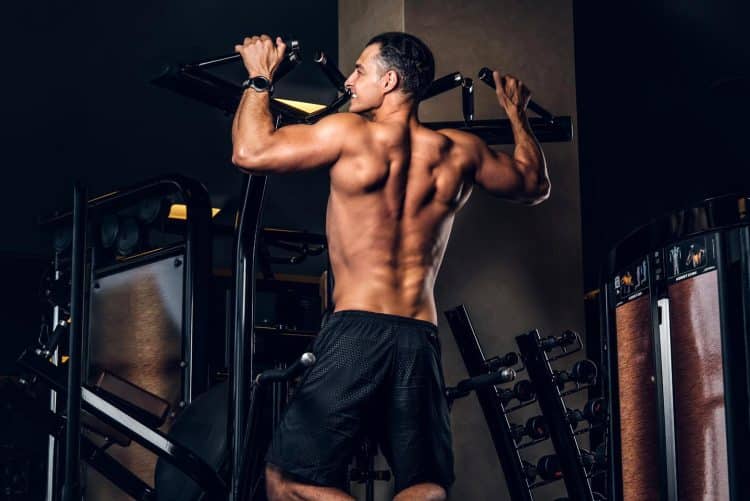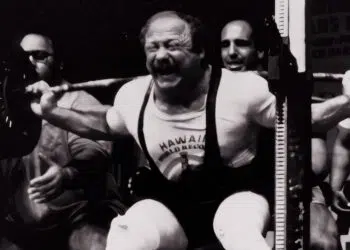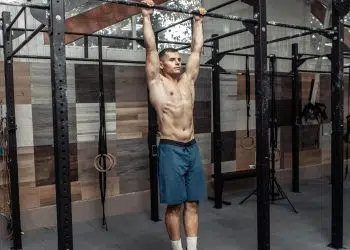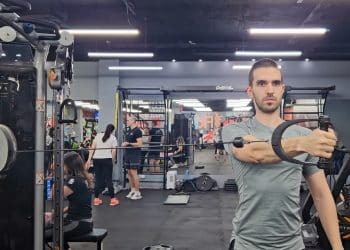Whether it’s a first backflip, slam-dunk, or the high coming off your first full pull-up, few things can compare to the limitless confidence gained from such achievements. But unlike trying to slam a ball ten feet high (Which is literally out of reach for most), or even dreaming of a rear somersault, we reckon the pull-up is a more realistic goal.
So how do you nail that unassisted pull-up if you can barely hang onto the bar, or lift yourself an inch? Well, you first need to understand that body weight plays a big role in pull-up performance. You can be a jacked bodybuilder or world-class strength athlete, and still lose a pull-up contest to someone nowhere near as strong. But having a decently strong back and arms is also negotiable. The band assisted pull-up gets our attention as a convenient technique for building those pull muscles, while also training according to specificity, which means if you want to get better at something, do that thing!
In this guide, you’ll learn how to harness that pulling power, and progress your pull-up training. Plus see the best band assisted pull-up variations to pair up with for even more back gains!
Muscles Worked During Band Assisted Pull-Ups
If you only had pull-ups and nothing else, it would be more than enough to build a strong and muscular back with matching biceps and forearms. It is that good!

A team effort, you need decent arm power, a capable upper posterior, and an alert and willing core. Let’s look at the muscles we’re building in this classic movement.
- Latissimus dorsi – Pull-ups are to lats, what squats are to quads. Taking up most of your back, the latissimus dorsi are like a vest worn on the rear torso starting from below the armpits, and extending down to just above the buttocks. Lats create motion at the shoulder, and move the torso with the arms overhead.
- Brachialis – Most people don’t know about this secret, often hidden muscle. Occupying space in the upper arms next to the outer biceps, brachialis not only contributes to arm gains, but it crosses into the forearm and is a strong elbow flexor.
- Brachioradialis – Also an arm flexor, brachioradialis is a forearm muscle that’s more powerful than your biceps when the palms are face down in pronation like during pull-ups.
- Deltoid Posterior – Pull movements activate the rear deltoids when the scapula and arms retract behind your body. Typically forgotten in an exercise regime, the posterior shoulders play a key role in lifting posture, rear strength, and front to back symmetry.
- Infraspinatus – A member of the rotator cuff family, infraspinatus is built around the shoulder joint, therefore, contributing to its motion and stability. In pull performances, infraspinatus externally rotates the upper arm.
- Levator Scapulae – A muscle that extends from the neck to the shoulder blades where or primarily lifts the scapula.
- Teres Major – While it’s hard to imagine, the teres major is like a crossbar from the scapula to the upper arm. There it moves the arm with help from the latissimus dorsi.
- Teres Minor – Another surprise is the the teres minor is a rotator cuff muscles while teres major is not. Therefore, minor acts with other muscles to move and stabilize the shoulder joint.
- Trapezius muscles – The upper back is equipped with a large trapezoid shaped group of parts, also known as the traps. Positionally, the upper traps rise above the collarbones touching the upper neck (occipital bone), while the middle traps continue down the back before the lower trap fibers that extend to roughly mid torso. Upper traps lift the shoulder blades, middle fibers pull them back, and lower portion draws them down.
How To Do Band Assisted Pull-ups
Before you attempt this exercise, make sure that you have a suitable loop resistance band. These are like giant rubber bands, not the tube shaped ones with two handles, which will roll up your shin or foot and smack you in the face.
Level Up Your Fitness: Join our 💪 strong community in Fitness Volt Newsletter. Get daily inspiration, expert-backed workouts, nutrition tips, the latest in strength sports, and the support you need to reach your goals. Subscribe for free!
The video example below shows the best type of band for this variation. Although, you’ll need to choose an appropriate resistance level or band strength for your experience level. We recommend starting with a heavier band, and working your way down.
Here’s a step by step breakdown of the band assisted pull-up with a video demonstration.
Steps
Note: We’ve broken the pull-up down into two steps – setup and execution.
Setup
- First, secure your band to the pull-up bar. To do this, throw one end of your band over the bar, then pull it all the way through into a knot. Pull against the band to ensure it’s properly attached.
- Then use both hands to pull the band down, bend your knee, and lift the upper shin onto the band. Keep your knee bent to hold the band in place. You can stand on a chair to help get the band on the shin.
- Now reach up and grab the bar with an overhand grip slightly wider than the shoulders.
- Bend the free leg to match the banded leg and hang from the bar.
- Pull your shoulder blades down, engage your lats, and tense your core.
Pull-up!
The perfect pull-up involves two steps, the pull and your body angle.
There are two common ways to perform a pull-up. The first with a totally straight body and vertical pull-up direction which requires more core, and doesn’t hit the back muscles as efficiently. The other, and better way to do a pull-up is with an extended spine, arched upper back, and an open chest toward the bar.
To do a perfect pull-up:
- Engage the lats, then as you pull up with your arms, tilt your head back, lean rearward, arch your back and lift your chest to the bar. Try to squeeze your shoulder blades together. Then slowly drop yourself down until the arms are fully extended. Repeat for the desired number of repetitions.
Watch this short 2-minute video tutorial on the band assisted pull-up.
Related: 8 Ways To Get Better At Pull-Ups and Chin-Ups
Alternative Setup
You can also use a power rack, and wrap both ends of the band around the barbell pegs at roughly waist height. Then, use a bench or step to reach the pull-up bar, and stand on the center of the band with both feet. This is a safe method as the j pegs or bar hooks keep the band from slipping off, and you won’t have the hassle of wrapping a band under your knee or foot.
Here’s an example.
Tips
- For safety reasons, we recommend placing the band on the knee, rather than under the foot. However, if you stand on the band with your foot, it will provide more resistance than the suggested technique.
- We recommend using a lower pull-up bar rather than a very high one. This way if anything goes wrong you’re at a safer distance to the floor.
- The thinner the band, the more challenging the pull-up. A heavier band will provide more assistance.
- You can vary your grip. However, avoid going too wide as it’s not efficient or safe for the elbows.
- The optimal grip is shoulder width or slightly wider.
Check out the top reviewed pull-up bars here.
Benefits of Band Assisted Pull-Ups
How beneficial is a band assisted pull-up? Considering its a variation of a top bodyweight exercise, there are many advantages to including it in your back sessions!
Build your pulling strength
Beginners especially tend to gravitate more towards the push based exercises like chest presses and triceps pushdowns. Then they’ll throw in a few cable pulldowns because, well, it looks like the popular thing to do. Don’t make that mistake.
You’ll create an imbalance between your anterior and posterior, limit your strength potential due to weak rear muscles, and increase your risk of injuries during resistance training.
Fill out those shirt sleeves…
While it’s true that pull-ups are programmed as a “back exercise”, we can’t ignore the arm gains potential of this bodyweight giant. It’s impossible to do a pull-up without the biceps, brachialis, and the forearms (And don’t let anyone tell you otherwise).
Develop an unbreakable grip
Oftentimes our grips give out before our muscles too, whether we’re performing pull-ups, or deadlifting lots of weight. The answer is to spend more time practicing exercises that require grip strength and endurance. Band assisted pull-ups allow you to do that without a full commitment.
It’s also safer on your joints and muscles to gradually overload your grip, rather than jump all in, especially during pull-ups.
Learn how to progress an exercise
Besides being a great back exercise, band assisted pull-ups get you in the habit of learning and experiencing training progression. All too often, people go to the gym or start an exercise regime, and they do the same thing every time, or stick with the easiest movements. The result? Little to no progress, and frustration.
But with the banded pull-up, you’re making a conscious effort to improve for a greater goal, aka the unassisted bodyweight pull-up!
Improve all markers of health
From building a stronger heart to burning calories, strengthening your body, and activating mood boosting hormones, band assisted pull-ups and its variations are one of the best choices for staying fit.
Drawbacks of Band Assisted Pull-Ups
If you do them correctly, banded pull-ups can be a powerful tool as you build your back and arm strength. However, there are potential downsides…
Don’t get whacked!
Anytime heavy rubber tubing is involved there’s always a risk of getting whacked in the face. However, that is if you use them carelessly, and also choose the wrong type of band. Avoid the round tubing and instead make sure to get the flat rubber band-like ones that will not roll around.
Level Up Your Fitness: Join our 💪 strong community in Fitness Volt Newsletter. Get daily inspiration, expert-backed workouts, nutrition tips, the latest in strength sports, and the support you need to reach your goals. Subscribe for free!
Not as practical
Compared to a pull-up assist machine, pulldowns, other pull-up variations, and even eccentric pull-ups, bands are not quite as convenient. That being said, if you’re if you have training experience, the band assisted pull-up is only an extra step, and shouldn’t require much preparation time.
Common Mistakes
You probably know not to do these things when performing pull-ups. But in case you needed reminded these are the mistakes you should avoid for the best results and injury prevention.
Half or quarter reps
There is a time and place for partial and quarter reps but only after you can perform a pull-up using full range of motion. That means starting with the arms extended and pulling your head above the bar. Not that half reps can’t be effective but you need to learn how to effectively engage all muscles and train joints and muscles to their full anatomical potential.
Swinging
While using momentum is an effective way to get your body from point A to point B, it certainly doesn’t provide the same strength and muscle building benefits when you have to use raw muscle power to pull yourself up. Even if you’re using bands, this can be a common error.
Asymmetrical reps
This is primarily a concern for beginners as they become aware of potential imbalances. It’s better to use a heavier band and focus on good form, pulling with equal strength in each arm and not letting one side assert its dominance.
Dropping down hard
You should never simply drop your body from the top of a pull-up. Doing so risks injury to your joints, even if you don’t feel it immediately. Moreover, the negative portion of a rep is proven to be equally important for muscle gains, not to mention its potential benefits.
6 Best Variations of Band Assisted Pull-Ups
The band pull-up is just one technique that you can use to build the upper posterior and arm muscles. There are other great options that have their own advantages too. Check out our favorite band assisted pull-up variations below.
Machine assisted pull-up
Most people would probably prefer to use an assisted pull-up machine rather than bands. It’s more ergonomic, supportive, and allows you to more easily track your progress. Not to mention, an obvious much better choice for new trainees, people with much less upper body strength, and elderly fitness lovers.
Bands are better for people who’ve been around the training block a few time, with a little training experience under their belt.
Australian pull-up
This one is an alternative to vertical full bodyweight pull-ups, but also a personal favorite that’s excellent regardless. Also called the inverted row, Australian pull-ups are typically performed from a reclined standing position underneath a smith machine bar, suspension straps or something similar, set to roughly waist or higher. The legs are extended with the heels on the ground which removes a significant percentage of weight from the movement.
You can use a smith machine bar, suspension straps, a sturdy table, broomstick and chairs, etc.
Jackknife pull-up
The jackknife pull-up starts from a similar position as the Australian pull-up, sitting on your butt. However, when performing jackknife pull-ups, the butt should touch the floor during each repetition. This is also a progression to help build up your pulling strength.
To make it a little easier, you can put a box, bench, or any object under your butt to decrease the start to finish distance.
Check out this demonstration.
Negative pull-up
Another clever way you can build up your pull muscles is with a negative pull-up. Find a way to get your chin above the bar without pulling up (e.g., jumping to the top or using a chair), then fight hard against your body weight pulling you down.
Learn how to use negative reps to build muscle and get stronger here.
Band assisted isometric pull-up
You can also go the isometric route, where you stop and hold during any position of a pull-up whether in the bottom, middle, or top. It’s a common technique used to build strength at any point during a repetition, where one is typically weaker.
Read: The science of isometric training – explained!
Pulldown
While nailing a pull-up is an incredible achievement for anyone, pulldowns are just as beneficial, although arguably less functional. But the advantages of pulldowns include having more control over the technique, choosing your resistance, more grip options (If using cables), and the ability to angle your body how you like.
Lat pulldowns vs. pull-ups: Which one should you do?
Unassisted pull-up
This one is between you and the bar… no bands or machines to back you up. At this point you should be able to nail at least four to five pull-ups with decent form.
Setup
Because you’re not using a band, we recommend a slight form modification for the unassisted pull-up.
- Reach up or jump up and grab the bar with an overhand grip slightly wider than the shoulders.
- Pull your shoulder blades down, engage your lats, and tense your core. Either keep the legs straight and together or crossed but don’t bend the knees and lift the feet behind you.
Then simply repeat the steps included for the band assisted pull-up at the top of this guide. You can find the instructions below for your convenience.
- Engage the lats, then as you pull up with your arms, tilt your head back, arch your back and lift your chest to the bar. Try to squeeze your shoulder blades together. Then slowly drop yourself down until the arms are fully extended. Repeat for the desired number of repetitions.
If you’d also like to see a demonstration of a proper pull-up we included a 4-minute tutorial below.
FAQs
What are the most important muscles when performing a pull-up?
Pull-ups require a team effort from several muscle groups, even the core and legs which help stabilize and transfer force efficiently. However, the back and arm muscles are what perform the actual pull-up.
What should I look for when choosing a pull-up band?
This really depends on your budget and experience.
If you have more to spend, then you may want to invest in a set of bands with varying levels of resistance. That way you can start with the heaviest and as you progress, work your way down to the lighter bands, or combine them for more precise assistance. Or, you can use them to train at higher rep ranges, and for drop sets.
If you’re a heavy person, 240+ pounds, or cannot do any or more than a few pull-ups, then we recommend a band that provides 100+ pounds of resistance, or the heaviest band you can find.
Likewise, if you just need a little boost to help you crank out a few extra reps, a lighter or medium band should work.
For those under 200 pounds who can perform 5-10 reps, a heavy band (40-80) should be adequate.
How many sets and reps of band assisted pull-ups should I do?
To make progress with any exercise, you need to be consistent. There’s no one size fits all program for everyone.
With that said we recommend 2-3 high effort sets per workout minimum, and a training frequency of twice per week for each muscle group.
Wrapping Up
If you’re determined to get that first pull-up, nothing can stop you. It may require a slight change in body composition, and/or lots of practice with band assisted pull-ups, and the other variations in this guide. But it’s entirely possible for almost any decently fit person who puts in the time.
Aside from the obvious benefits like building a sexy back or adding more muscle to your biceps, you’ll also learn the process of progression, and its a very rewarding thing to see the fruits of your efforts!
Interested in measuring your progress? Check out our strength standards for Pull Ups, Deadlift, Chest Press, and more.








